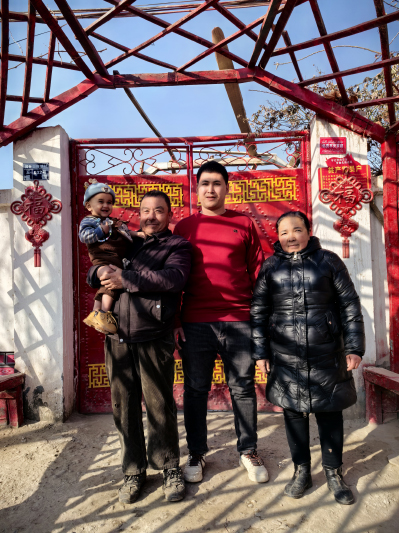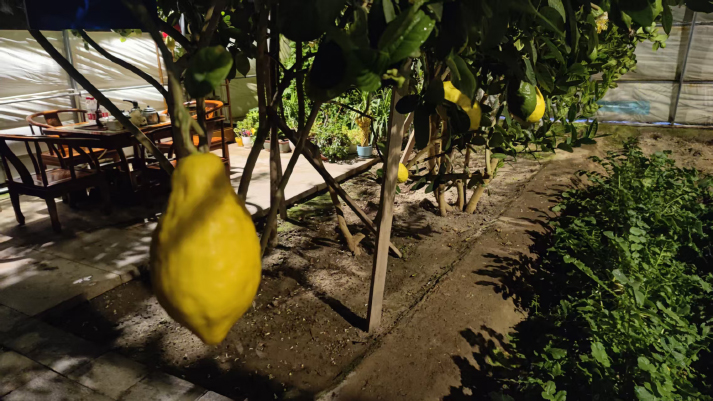| Xinjiang Today |
| Human-centered development in south Xinjiang | |
|
|
|
A truck enters China from Pakistan through the Hongqilafu Pass in Kashi Prefecture on January 2 (XINHUA)
Harsh winter gripped the southern part of Xinjiang Uygur Autonomous Region in early January, with the majestic Kunlun Mountains shrouded in ice and snow and the Tarim Basin shivering in the cold. Yet, amid this frigid landscape, a story of warmth emerged, as residents' lives experience a transformative shift. South Xinjiang, located south of the Tianshan Mountains, is less economically developed than the northern part of the autonomous region. As a result, it is a primary focus for development programs aimed at boosting growth and improving residents' living standards.
 Turup Mamattursun (center) poses with family members in front of their house in Kuoshiwusitang Village, Shache County, Kashi Prefecture, on December 31, 2024 (XIAO CHUNFEI)
Coal to electricity In Kuoshiwusitang Village, Shache County in Kashi (Kashgar) Prefecture, the contrast between the biting outdoor chill and the cozy warmth indoors was striking. Turup Mamattursun, the homeowner, greeted visitors in a light sweater, a testament to the effectiveness of the electric heating system installed by the government two years ago. This coal-to-electricity initiative has not only brought physical warmth but has also enhanced safety and cleanliness, with energy costs dropping considerably. Implemented between 2019 and 2021, the first phase of the project benefited 892,000 rural households in south Xinjiang. The second phase, running from 2022 to 2024, continued to expand these benefits. Officials highlight the project's success in reducing coal use and pollution, leading to improved air quality during the harsh winter months. Kuoshiwusitang embraced this change in 2021, with government-funded installations of electric heating systems. For Turup's household, this shift has eliminated the nightly chore of stoking coal fires and the seasonal worry about lingering cold spells that might arrive after the dismantling of stoves. Today, electric heating ensures a steady flow of warmth with a simple flip of a switch. The new heating system has revolutionized domestic life, providing consistent warmth and reducing the risk of burns and carbon monoxide poisoning. Economically, the coal-to-electricity initiative has slashed winter heating costs from over 2,500 yuan ($343) for coal to approximately 800 yuan ($109) for electricity. Convenience is another benefit, as Turup and his wife can recharge their electric meter via the Weixin superapp, known as WeChat internationally, ensuring their home remains warm without fear of power outages. Once a household grappling with poverty, Turup's family now thrives, thanks in part to these improvements. Their new home, a stark contrast to their previous cold and dusty abode, is warm, clean, and well-organized. The coal-to-electricity initiative is part of a broader transformation in south Xinjiang, where modern technology and government support converge to uplift communities. In another household in the village, Abdurxit Abduryim works as a chef in the city, while his wife, Arzigul Abliz, manages their farm at home. Wearing a bright pink coat, Arzigul cheerfully shared that in 2024, the couple cultivated 0.3 hectares of marigolds, a plant with medicinal properties, earning their family an additional 13,500 yuan ($1,850). Lin Tao, deputy head of Yingwusitang Township, which administers Kuoshiwusitang, described this income as the villagers' "pocket money." Arzigul told Xinjiang Today, "When I was a child, if I wanted to buy something, I had to secretly ask my mother, who would then ask my father for money, and it wasn't always guaranteed I would get what I had asked for. Now, I have my own income and can buy whatever I want. And if my son wants something, I can buy it for him too."  The White Sand Mountain and White Sand Lake scenic area in Aketao County, Kizilsu Kirgiz Autonomous Prefecture, on January 1 (XIAO CHUNFEI)
Tourism improvements From Kashi, we ascended to the Pamir Plateau via the Karakorum Highway to reach Bulunkou Township in Aketao (Akto) County, Kizilsu Kirgiz Autonomous Prefecture, where we encountered the stunning White Sand Mountain and White Sand Lake scenic area. The Karakorum Highway connects Kashi with Islamabad, the capital city of Pakistan, which shares a border with Xinjiang in the mountainous region of the Karakorum Range. In winter, the landscape in this location is surreal, with the frozen, deep blue lake surface dotted with unique ice bubbles, drawing numerous tourists. However, despite the biting wind outside, we found warm water flowing from the sensor faucets in the restrooms at the scenic spot, which surprised us. In 2024, over 300 million tourist trips were made to and within Xinjiang, a new record. This surge in tourism is attributed to improvements in both infrastructure and service quality. That same year, the cultural and tourism sector was officially recognized as one of the region's top 10 industry clusters. It was also a year for enhancing tourism service quality, with multiple departments collaborating to address pricing, sanitation, and tour group issues, while focusing on improving dining, accommodation, transportation, and safety standards. The results of the endeavors are tangible, evidenced by the warm water in the restrooms amid the winter chill. For south Xinjiang, tourism has implications beyond leisure; it is pivotal in boosting employment, enriching local communities and fostering ethnic unity. Xinjiang has issued a dedicated tourism development plan (2023-30) for its southern prefectures to leverage tourism for economic and social benefits. Kashi's Ancient City is a major drawing card. With a history of more than 2,000 years, it offers a glimpse into the past glory of the Silk Road. The ancient city was a crossroads of civilizations, where traders and travelers from different regions converged, resulting in a rich cultural tapestry. From January to November 2024, 41.22 million tourist trips were made to and within Kashi, generating 35.3 billion yuan ($4.8 billion) in tourism revenue, or increases of 26.66 percent and 31.53 percent, respectively, from the previous year. In late 2024, an immersive performance titled Encounter Kashi made its stage debut. The show, developed over nine months with an investment of over 230 million yuan ($31 million), centers on the preservation of the national intangible cultural heritage Twelve Muqam, the Kashi local style of the traditional Muqam art that blends elements of singing, dancing and music. Muqam is a traditional form of folk music and performance art that is particularly associated with the Uygur ethnic group in Xinjiang. Cutting-edge artistic techniques make the show a new hallmark of cultural tourism in Kashi. "We hope this immersive performance will allow people from around the world to experience the charm of Xinjiang and Kashi, offering a rich cultural feast," said Li Xinping, General Manager of Western Tourism, one of the show's producers.  Fruit grown in a greenhouse at the Hongqilafu Pass in Tashikuergan Tajik Autonomous County, Kashi Prefecture, on January 1 (QIAN YONGWEN)
Plateau produce At the Hongqilafu (Khunjerab) Pass, the world's highest border crossing at 5,100 meters, a Pakistani truck driver traveling on the Karakorum Highway greeted us with a cheerful "Happy New Year" in broken standard Chinese. As of December 1, 2024, the pass is open year-round despite its extreme conditions of freezing temperatures and seasonal snow. The pass, previously closed during the harsh winter months, has been equipped with advanced facilities, including heated interiors and oxygen supply. The border checkpoint now features a tropical greenhouse, where fresh fruit and vegetables, including those grown from space-bred seeds, thrive, a stark contrast to the frozen landscape outside. This transformation is largely credited to Sun Chao, a former border guard who pioneered vegetable cultivation on the harsh Pamir Plateau, overcoming the altitudes and inclement climate to grow 39 types of vegetables. His efforts have sparked a greenhouse farming boom in Tashikuergan (also spelt Taxkorgan or Tashkurgan) Tajik Autonomous County, where the Hongqilafu Pass is located. Now modern greenhouses in the county yield over 1,000 tons of produce annually, some even reaching markets beyond the plateau. The Hongqilafu area has seen infrastructural improvements, like the establishment of flight routes to Tashikuergan, enhancing supply chains. Yet, the spirit of self-reliance endures, as residents continue to cultivate their own produce, maintaining a sense of home and community in this challenging environment. (Print Edition Title: From Frost to Flourish) Comments to yanwei@cicgamericas.com |
|
||||||||||||||||||||||||||||
|